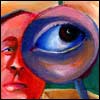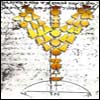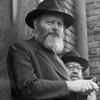Rabbi Menachem Mendel’s studies at Berlin’s Friedrich Wilhelm (Humboldt) University coincided with Erwin Schrödinger’s tenure as Professor of Theoretical Physics.1 Many years later, in conversation with the American mathematician Paul Rosenbloom, the Rebbe recalled that he enjoyed Schrödinger’s lectures very much.2
During this period Schrödinger was embroiled in a debate with other leading physicists over how to interpret the counterintuitive and paradoxical findings of quantum mechanics. Light was found to behave both like particles and like waves, depending on the kind of experiment set up to observe its behavior. According to Werner Heisenberg, this showed that objective reality is actually an indeterminate spectrum of possibilities; only subjective observation forces any one of those possibilities to materialize. Schrödinger disagreed. The indeterminate findings of quantum mechanics, he asserted, simply mirrored the incompleteness of the current theory.3 “There is a difference,” he wrote, “between a shaky or out-of-focus photograph and a snapshot of clouds and fog banks.”4
Albert Einstein, who was also on the faculty in Berlin at the time, but didn’t teach, shared Schrödinger’s concerns. It was his correspondence with Einstein that helped Schrödinger formulate the cat thought experiment to demonstrate the absurdity of Heisenberg’s position.5 Heisenberg’s “uncertainty principle” can be interpreted in various ways and has been supplemented with various theories, leaving the discussion open until today.6 Together with Einstein’s theory of relativity, according to which phenomena can no longer be measured in absolute terms, the uncertainty principle thoroughly undermines the classical notion that the empirical observations of science can provide a precise account of objective truth.7
The Rebbe’s position, formulated in various letters over the years, might be seen as a mediation between the two poles articulated by Heisenberg and Schrödinger.8 But more importantly it constitutes a mediation between science and religion. The Rebbe accepted the uncertainty principle as a scientific self-description of the limits of scientific investigation, but not as a conclusive statement about the nature of reality. This position rested on his surprising assertion that the Torah view of science is actually “at variance” with science's newfound self-circumscription:
“Where in the past scientific conclusions were considered as natural ‘laws’ in the strict sense of the term, i.e. determined and certain, modern science no longer holds this view. Parenthetically, this view is at variance with the concept of nature and our own knowledge of it (science) as espoused by the Torah, since the idea of miracles implies a change in a fixed order and not the occurrence of a least probable event.”9
The Torah perspective is predicated on divine revelation, which asserts a foundation of absolute certainty. In contrast, scientific scrutiny of its own foundations arrived at the uncertainty principle, generally regarded as the best candidate for a universal description of the physical world. For the Rebbe this did not undermine the legitimacy of science, but rather crystallized the terms of its relationship to Torah. In his view, the assumption that science should dictate those terms was fundamentally flawed.10 On the contrary, it was only by virtue of Torah’s authority that science too could be endowed with a measure of certainty:11
“As a matter of fact, the Torah bestows upon science - in certain areas at least - a validity much greater than contemporary science itself claims. The Halacha accepts scientific findings, in many instances, not as possible or probable, but certain and true... In the light of what has been said above... modern science cannot legitimately (and I mean ‘legitimately’ even from the viewpoint of science itself) challenge Torah from Sinai.”12
Accordingly, the Rebbe insisted that a religious Jew, even a professional scientist, should not have any qualms about accepting a literal reading of the Torah’s description of creation, or any other Torah deviation from commonly accepted scientific theory.13
The developments in quantum theory during the years that the Rebbe was in Berlin deeply impacted his perception of the relationship between Torah and science. In a 1962 interview with the Israeli journalist Shlomo Nakdimon the Rebbe remarked:
"The discoveries in the laws of atoms shake up the very foundations according to which science worked until now. Until now, they said science is stable, but Torah is no more than belief. Now we see that the premises of science and technology do not have lasting truth. These revelations were made specifically through the study of the atom….”14
Scientific method is an excellent tool in the hands of humanity, but none of its hypotheses warrant apologetic reinterpretation of the Divine word. Such apologetics were characterized by the Rebbe as “the outmoded legacy of the 19th century and before.”15 It was precisely the advances made by modern science that rendered them obsolete. With the old confusions cleared up, he argued, Torah and science are today free to progress in collaborative harmony.16
The function of Torah, and especially Chassidism, is to reveal the unity of G‑d in the world.17 Previously scientists thought that the universe was composed of many different elements, but modern science reduces everything to the union of energy and matter. Science itself, the Rebbe said, is discovering the underlying unity of all existence.18








Join the Discussion